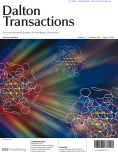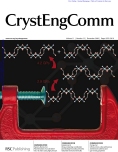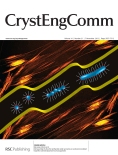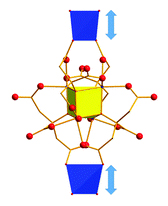Selected publications
or see our full publication list
 |
 |
 |
 |
High pressure studies:
Chem. Sci., 2018, 9, 1551.
"Understanding and controlling magnetic anisotropy at the level of a single metal ion is vital if the miniaturization of data storage is to continue to evolve into transformative technologies. Magnetic anisotropy is essential for a molecule-based magnetic memory as it pins the magnetic moment of a metal ion along the easy axis. Devices will require deposition of magnetic molecules on surfaces, where changes in molecular structure can significantly alter magnetic properties. Furthermore, if we are to use coordination complexes with high magnetic anisotropy as building blocks for larger systems we need to know how magnetic anisotropy is affected by structural distortions. Here we study a trigonal bipyramidal nickel(II) complex where a giant magnetic anisotropy of several hundred wavenumbers can be engineered. By using high pressure, we show how the magnetic anisotropy is strongly influenced by small structural distortions. Using a combination of high pressure X-ray diffraction, ab initio methods and high pressure magnetic measurements, we find that hydrostatic pressure lowers both the trigonal symmetry and axial anisotropy, while increasing the rhombic anisotropy. The ligand-metal-ligand angles in the equatorial plane are found to play a crucial role in tuning the energy separation between the dx2-y2 and dxy orbitals, which is the determining factor that controls the magnitude of the axial anisotropy. These results demonstrate that the combination of high pressure techniques with ab initio studies is a powerful tool that gives a unique insight into the design of systems that show giant magnetic anisotropy."
Nat. Commun., 2016, 7, 13870.
"Materials that demonstrate long-range magnetic order are synonymous with information storage and the electronics industry, with the phenomenon commonly associated with metals, metal alloys or metal oxides and sulfides. A lesser known family of magnetically ordered complexes are the monometallic compounds of highly anisotropic d-block transition metals; the ‘transformation’ from isolated zero-dimensional molecule to ordered, spin-canted, three-dimensional lattice being the result of through-space interactions arising from the combination of large magnetic anisotropy and spin-delocalization from metal to ligand which induces important intermolecular contacts. Here we report the effect of pressure on two such mononuclear rhenium(IV) compounds that exhibit long-range magnetic order under ambient conditions via a spin canting mechanism, with Tc controlled by the strength of the intermolecular interactions. As these are determined by intermolecular distance, ‘squeezing’ the molecules closer together generates remarkable enhancements in ordering temperatures, with a linear dependence of Tc with pressure."
Chem. Commun., 2016, 52, 7486.
"Negative linear compressibility (NLC), the increase in a unit cell length with pressure, is a rare phenomenon in which hydrostatic compression of a structure promotes expansion along one dimension. It is usually a consequence of crystal structure topology. We show that the source of NLC in the Co(II) citrate metal–organic framework UTSA-16 lies not in framework topology, but in the relative torsional flexibility of Co(II)-centred tetrahedra compared to more rigid octahedra."
Single-ion magnets / High-Frequency EPR:
Chem. Sci., 2015, 6, 6823.
"Monometallic complexes based on 3d transition metal ions in certain axial coordination environments can exhibit appreciably enhanced magnetic anisotropy, important for memory applications, due to stabilisation of an unquenched orbital moment. For high-spin trigonal bipyramidal Ni(II), if competing structural distortions can be minimised, this may result in an axial anisotropy that is at least an order of magnitude stronger than found for orbitally non-degenerate octahedral complexes. Broadband, high-field EPR studies of [Ni(MDABCO)2Cl3]ClO4 (1) confirm an unprecedented axial magnetic anisotropy, which pushes the limits of the familiar spin-only description. Crucially, compared to complexes with multidentate ligands that encapsulate the metal ion, we see only a very small degree of axial symmetry breaking. 1 displays field-induced slow magnetic relaxation, which is rare for monometallic Ni(II) complexes due to efficient spin-lattice and quantum tunnelling relaxation pathways.
Inorg. Chem., 2015, 54, 13.
"High-field electron paramagnetic resonance spectroscopy shows that the structurally distorted Mn(III) ion in Na5[Mn(l-tart)2]·12H2O (1; l-tart = l-tartrate) has a significant negative axial zero-field splitting and a small rhombic anisotropy (∼1% of D). Alternating-current magnetic susceptibility measurements demonstrate that 1, which contains isolated Mn(III) centers, displays slow relaxation of its magnetization under an applied direct-current magnetic field."
Chem. Soc. Rev., 2015, 44, 2135.
"One of the determining factors in whether single-molecule magnets (SMMs) may be used as the smallest component of data storage, is the size of the barrier to reversal of the magnetisation, Ueff. This physical quantity depends on the magnitude of the magnetic anisotropy of a complex and the size of its spin ground state. In recent years, there has been a growing focus on maximising the anisotropy generated for a single 3d transition metal (TM) ion, by an appropriate ligand field, as a means of achieving higher barriers. Because the magnetic properties of these compounds arise from a single ion in a ligand field, they are often referred to as single-ion magnets (SIMs). Here, the synthetic chemist has a significant role to play, both in the design of ligands to enforce propitious splitting of the 3d orbitals and in the judicious choice of TM ion. Since the publication of the first 3d-based SIM, which was based on Fe(II), many other contributions have been made to this field, using different first row TM ions, and exploring varied coordination environments for the paramagnetic ions."
Heterometallic complexes:
Chem. Commun., 2017, 53, 4799.
"The adiabatic temperature change of the star-shaped {CoIII3GdIII3} magnetocaloric ring is enhanced via topological control over the assembly process, by using a pre-formed {CoII(H6L)} building block that undergoes oxidation to CoIII, successfully separating the GdIII ions."
Chem. Eur. J., 2016, 22, 12839.
"We report a series of 3d–4f complexes {Ln2Cu3(H3L)2Xn} (X=OAc−, Ln=Gd, Tb or X=NO3−, Ln=Gd, Tb, Dy, Ho, Er) using the 2,2′-(propane-1,3-diyldiimino)bis[2-(hydroxylmethyl)propane-1,3-diol] (H6L) pro-ligand. All complexes, except that in which Ln=Gd, show slow magnetic relaxation in zero applied dc field. A remarkable improvement of the energy barrier to reorientation of the magnetisation in the {Tb2Cu3(H3L)2Xn} complexes is seen by changing the auxiliary ligands (X=OAc− for NO3−). This leads to the largest reported relaxation barrier in zero applied dc field for a Tb/Cu-based single-molecule magnet. Ab initio CASSCF calculations performed on mononuclear TbIII models are employed to understand the increase in energy barrier and the calculations suggest that the difference stems from a change in the TbIII coordination environment (C4v versus Cs)."
Inorg. Chem., 2014, 53, 8970.
"We have determined the exchange interactions in new {TbCu3} and {DyCu3} SMMs, with inelastic neutron scattering (INS) spectroscopy. We found that the fundamental INS excitations correspond to CuII spin flips. These have energies similar to the thermodynamic barriers for magnetization reversal, which we determined using ac magnetic susceptibility measurements. This indicates the importance of these spin flips for the magnetic relaxation and therefore the importance of the 3d−4f exchange interactions for the thermodynamic energy barrier."
Angew. Chem. Int. Ed., 2013, 52, 1949.
"A two-step method for the directed synthesis of high-nuclearity MnIII-MnII-CuII heterometallic transition metal complexes is described. The synthesis starts from a preformed copper(II) complex to trap an inner hexacapped cuboctahedral manganese oxide core."
